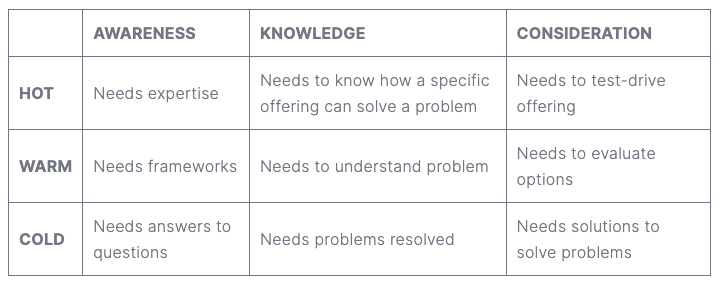I’m an impulse buyer. Any and every toy for my kids? Yes, please. The air fryer that’s all over Instagram is definitely in my kitchen. And let’s talk about the checkout lane. I can always use more candles, a new phone case, and coffee mugs.
But when it comes to big-ticket items, my buying journey is very different. My path to purchase is a process and I rarely raise my hand until I’ve done some research.
If you find yourself nodding your head, you’re not alone: 81% of consumers research online before making a purchase. And SaaS buyers complete 60%+ of the buying process before engaging a vendor.
We know the buyer journey is full of twists and turns and it’s our job as marketers to deliver the right customer experience at each inflection point. Ultimately, our goal is to guide consumers through this journey so they make a purchase from us.
The right CTAs encourage our audience to take action. Gartner calls this “buyer enablement” — providing information to customers in a way that enables them to complete critical buying decisions.
The wrong CTA can turn potential customers away — something I see many of our clients struggling with. Many of us think using “Get a Demo” or “Let’s Talk” is the only way to go. But accelerating the buying journey is as if you’re serving the dessert before the appetizer.
We need to guide prospects through the buyer’s journey, not steer them off course. The first step is to understand the buyer journey so we can reach our customers where they are in each stage. Then we need to develop a robust content marketing strategy that presents content for each stage of the buyer’s journey with CTAs that encourage the appropriate action and drive growth.
Aligning Intent to Action
It’s important to align our calls-to-action to the buyer journey to optimize performance of our campaigns. Sure, we might get lucky to land a handful of demos, but we’re missing out on prospects who are early in their buying journey.
We can all relate to these frustrations when our executives ask why the numbers have dropped off. Why would the “Get Demo” CTA bring in leads last quarter but has been falling flat now? These conversations made me think of my recent buyer journey.
Problem: My best friend from college bought an RV to prioritize creating experiences with her family. My husband and I thought this was a great idea and began our shopping journey.
Awareness: Our research was focused on understanding the different types of RVs and price ranges, and we even started looking into family-friendly RV destinations.
Knowledge: There’s a lot we don’t know about RVs so we dug in even more: floorplans, new or used, ways to tow an RV, etc.
Consideration: Then we started to think about our budget and discussed what other things we might need to put on hold to afford our investment.
In this process, we’re searching for answers to:
- What is the challenge I have to solve?
- What are my options for solving this problem?
- How do I sort and filter those options to meet my very specific means?
- How do I compare the options?
- How do I figure out the ones that are best for my budget, lifestyle, business, etc.?
- How do I fully understand the options?
For each type of question above, we (marketers) need to craft the correct CTA to match the intent of our audience: Whether they’re researching their problem, solution, options, or different brands. Presenting a “Buy Now” offer will fall flat because the customer hasn’t reached a decision yet. This is the time to serve up helpful content to educate and provide answers to their questions.
The Right Content for the Right Stage
Marketing is impossible without great content. Buyers need to engage with 8-13 pieces of content before making a decision. That’s a mix of first- and third-party content in the forms of social posts, blogs, earned media, reports, etc.
Consider the information below, which shows the different types of content you need to be thinking about for the different stages of the buyer journey and the different types of leads you have.

Awareness
- Users focus primarily on learning more about their problem. They’re not interested in your product and certainly aren’t ready for a demo, but they want to find a solution to eliminate their pain points.
- Serve them content that educates, such as blog posts, social content, videos, and ebooks. Show them how your product can eliminate or reduce their pain points.
- CTAs can be “Subscribe To” “Follow Us” “Find Inspiration”
Consideration
- These prospects have already learned a lot about their problem, discovered some potential solutions, and are evaluating their options.
- Deliver content that will position your product as the best solution, such as case studies, webinars, and comparison guides.
- CTAs can be “Watch Now” “See How We Stack Up” “Read Case Study”
Purchase
- These buyers know what they want. They’re looking for the right features, support, integrations, and cost.
- This is where you can splash “Request a Demo” and “Free Trial”
The End Result: Great CX
The buying process is always happening, regardless of the good or service — candles, air fryers, RVs, software, etc. But, the time to move through the buying process is different. While we can’t force prospects to skip steps, great marketer’s find creative ways to accelerate the process.
Tying the CTA to the customer journey should make sense to those stages. Because great experiences delight customers, happy customers keep coming back for more, and they spread the word.
I encourage you to study and understand the buying journey, develop your funnel around those inflection points, and create a content marketing strategy that maps content to each phase of their journey using the right CTAs.
I should know. After researching the RVs, I finally raised my hand and reached out to an RV dealer. Our first trip is going to be to Nashville, TN, in a few weeks.
Related: Looking for a Social Media Manager? Steal This Job Description

